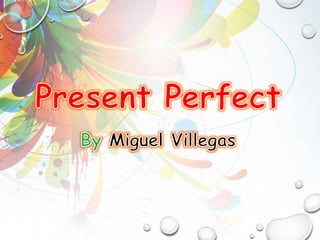Present Perfect and Past Perfect
•Télécharger en tant que PPTX, PDF•
4 j'aime•1,110 vues
Explanation about the Present Perfect and the Past Perfect
Signaler
Partager
Signaler
Partager

Recommandé
Contenu connexe
Tendances
Tendances (20)
The Sentence | Basics of English | English Grammer

The Sentence | Basics of English | English Grammer
En vedette
This SlideShareshares the need for translating and localizing training programs and also the steps involved in an effective e-learning course translation process.How to Get Online Course Translations of the Highest Quality

How to Get Online Course Translations of the Highest QualityCommLab India – Rapid eLearning Solutions
En vedette (15)
How to Get Online Course Translations of the Highest Quality

How to Get Online Course Translations of the Highest Quality
Реализация полномочий по контролю закупок органом исполнительной власти субъе...

Реализация полномочий по контролю закупок органом исполнительной власти субъе...
Similaire à Present Perfect and Past Perfect
Similaire à Present Perfect and Past Perfect (20)
Plus de Mike Villegas
Plus de Mike Villegas (19)
Dernier
This presentation was provided by William Mattingly of the Smithsonian Institution, during the third segment of the NISO training series "AI & Prompt Design." Session Three: Beginning Conversations, was held on April 18, 2024.Mattingly "AI & Prompt Design: The Basics of Prompt Design"

Mattingly "AI & Prompt Design: The Basics of Prompt Design"National Information Standards Organization (NISO)
Dernier (20)
Beyond the EU: DORA and NIS 2 Directive's Global Impact

Beyond the EU: DORA and NIS 2 Directive's Global Impact
Call Girls in Dwarka Mor Delhi Contact Us 9654467111

Call Girls in Dwarka Mor Delhi Contact Us 9654467111
Mattingly "AI & Prompt Design: The Basics of Prompt Design"

Mattingly "AI & Prompt Design: The Basics of Prompt Design"
social pharmacy d-pharm 1st year by Pragati K. Mahajan

social pharmacy d-pharm 1st year by Pragati K. Mahajan
Measures of Central Tendency: Mean, Median and Mode

Measures of Central Tendency: Mean, Median and Mode
Ecosystem Interactions Class Discussion Presentation in Blue Green Lined Styl...

Ecosystem Interactions Class Discussion Presentation in Blue Green Lined Styl...
Present Perfect and Past Perfect
- 2. -The Present Perfect is formed by combining the auxiliary verb Has or Have with the Past Participle. Example: • Affirmative -I, you, we, they + have spoken. -He, she, it + has spoken. It’s very common to use the contractions ‘ve and ‘s in the present perfect: -I’ve spoken in English for several hours. -She’s spoken in English since 11 am.
- 3. • Negative -I, you, we, they + have not spoken. -He, she, it + has not spoken. It’s very common to use the contractions haven’t and hasn’t in the negative form: -I haven’t spoken in Spanish for several hours. -She hasn’t spoken in Spanish since 11 am. • Question -I, you, we, they = Have they spoken in English? -He, she, it = Has she spoken in Spanish?
- 4. -For Regular Verbs, we just add “ed”: Exceptions in spelling when adding ”ed” Example -After a final ”e” only add ”d” Love – Loved -Final consonant after a vowel Admit – Admitted is doubled. Travel – Travelled - Final ”y” after a consonant Hurry - Hurried becomes ”i“ -For Irregular Verbs, we use the participle form.
- 6. The Present Perfect expresses An action that started in the past and continues in the present. - My cousin has lived in this city for six months. - I have been playing the piano since 8 pm.
- 7. We use for and since with the Present Perfect: For is used with a period of time or lenght of time. Example: How long have they studied English? - They have studied English for two years. Since is used with a specific point in time. Example: How long has he worked there? - He has worked there since 2009.
- 9. -The Past Perfect is formed by combining the auxiliary verb Had with the Past Participle. Example: • Affirmative -I, you, he, she, it, we, they + had travelled. It’s common to use the contraction ‘d in the past perfect: -I’d travelled to New York before I was 20 years old.
- 10. • Negative - I, you, he, she, it, we, they + had not travelled. It’s very common to use the contraction hadn’t in the negative form: -She hadn’t travelled to New York before I came to Colombia. • Question -I, you, we, he, she, it, they = Had they travelled to New York before I came to Colombia?
- 11. The Past Perfect expresses an action that happened before a moment in the past. - I had learned to drive before I bought a car.
- 12. We use before and after with the Past Perfect: Had she read the book before the movie? - Yes, she had read the book before she saw the movie. - She saw the movie after she had read the book.